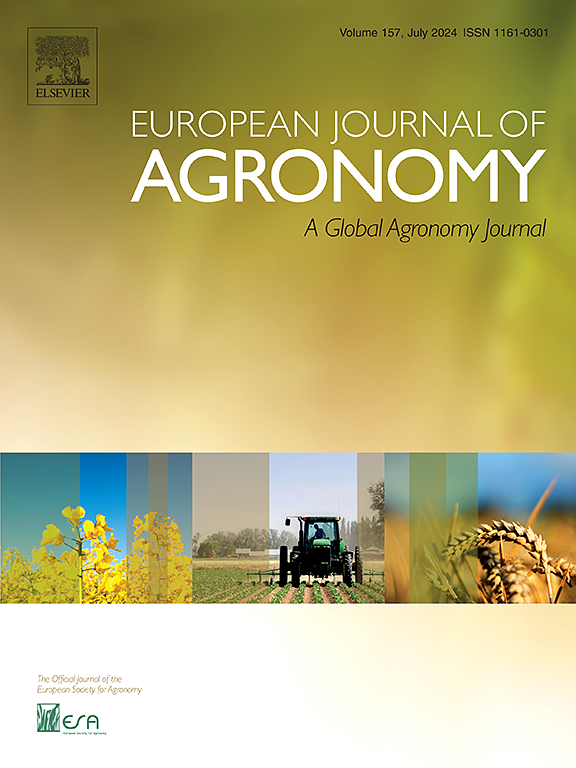Input uncertainty in CSM-CERES-wheat modeling: Dry farming and irrigated conditions using alternative weather and soil data
IF 4.5
1区 农林科学
Q1 AGRONOMY
引用次数: 0
Abstract
In the current study, the uncertainties of wheat modeling using gridded soil and weather datasets were analyzed under dry farming and irrigated conditions. In this regard, the performance of the CSM-CERES-Wheat model forced with different weather-soil data combinations was studied in some dryland regions in Iran based on normalized Root Mean Square Error (nRMSE), Kling-Gupta Efficiency (KGE), and Percent Bias (PBIAS). The data combination scenarios were WS-SO: soil observations and gridded weather datasets including ERA5-Land (WE-SO) and the combinations of non-precipitation ERA5-Land forcings with CHIRPS (WCE-SO) and PERSIANN-CDR (WPE-SO), SoilGrids250m gridded soil data and weather observations (WO-SS), and soil and weather observations (WO-SO). Although the CHIRPS-ERA5L improved simulations relative to ERA5-Land and PERSIANN-CDR-ERA5-Land, there was still an nRMSE greater than 30 %, a KGE below 0.50, and an absolute PBIAS exceeding 25 % for dry farming yield in most drylands under WS-SS and WS-SO, indicating significant input uncertainties. The high uncertainty in dry farming wheat yield under WS-SS and WS-SO can be attributed to the uncertainties in simulating the water stress index in CSM-CERES-Wheat. The dry farming wheat yield was, however, simulated satisfactorily with SoilGrids250m products for WO-SS. The dry farming wheat yield showed the largest sensitivity to the uncertainty in precipitation forcing. The notable uncertainty in water stress simulation, and therefore in dry farming yield, appears to stem from the high uncertainty in precipitation products. These findings demonstrate that dry farming modeling is subject to notable input uncertainty when reliable meteorological records are lacking in our study area. SoilGrids250m can be reliably used to model wheat yield under dry farming conditions in the study area when weather observations are available. However, the applicability of SoilGrids250m largely depends on the availability of regional soil observations. Irrigated wheat yield was successfully simulated due to the reduced uncertainty in water stress. Therefore, using alternate weather-soil data provides a robust solution to data unavailability when wheat water requirements are sufficiently met. Nonetheless, caution is needed when using gridded weather datasets to force the CSM-CERES-Wheat model for dry farming.
CSM-CERES 小麦建模中的输入不确定性:使用替代天气和土壤数据的旱作和灌溉条件
本研究分析了在旱作和灌溉条件下使用网格化土壤和气象数据集建立小麦模型的不确定性。为此,根据归一化均方根误差(nRMSE)、克林-古普塔效率(KGE)和偏差百分比(PBIAS),研究了在伊朗一些旱地地区强制使用不同气象-土壤数据组合的 CSM-CERES 小麦模型的性能。数据组合方案有:WS-SO:土壤观测数据和网格化气象数据集,包括ERA5-Land(WE-SO)以及非降水ERA5-Land与CHIRPS(WCE-SO)和PERSIANN-CDR(WPE-SO)、SoilGrids250m网格化土壤数据和气象观测数据(WO-SS)以及土壤和气象观测数据(WO-SO)的组合。虽然 CHIRPS-ERA5L 的模拟结果比 ERA5-Land 和 PERSIANN-CDR-ERA5-Land 有所改进,但在 WS-SS 和 WS-SO 条件下,大多数旱地的旱作产量的 nRMSE 仍大于 30%,KGE 低于 0.50,PBIAS 的绝对值超过 25%,表明输入的不确定性很大。WS-SS 和 WS-SO 条件下旱作小麦产量的高不确定性可归因于 CSM-CERES-Wheat 中模拟水分胁迫指数的不确定性。然而,在 WO-SS 条件下,SoilGrids250m 产品对旱作小麦产量的模拟效果令人满意。旱作小麦产量对降水强迫不确定性的敏感性最大。水分胁迫模拟的显著不确定性,以及旱作产量的不确定性,似乎源于降水产品的高度不确定性。这些研究结果表明,在我们的研究区域缺乏可靠气象记录的情况下,旱作农业建模会受到显著输入不确定性的影响。在有气象观测资料的情况下,SoilGrids250m 可以可靠地用于模拟研究地区旱作条件下的小麦产量。然而,SoilGrids250m 的适用性在很大程度上取决于区域土壤观测数据的可用性。由于水压力的不确定性降低,成功模拟了灌溉小麦产量。因此,在充分满足小麦水分需求的情况下,使用交替气象-土壤数据为数据不可用提供了一个稳健的解决方案。尽管如此,在使用网格气象数据集强制 CSM-CERES 小麦模型进行旱作时仍需谨慎。
本文章由计算机程序翻译,如有差异,请以英文原文为准。
求助全文
约1分钟内获得全文
求助全文
来源期刊

European Journal of Agronomy
农林科学-农艺学
CiteScore
8.30
自引率
7.70%
发文量
187
审稿时长
4.5 months
期刊介绍:
The European Journal of Agronomy, the official journal of the European Society for Agronomy, publishes original research papers reporting experimental and theoretical contributions to field-based agronomy and crop science. The journal will consider research at the field level for agricultural, horticultural and tree crops, that uses comprehensive and explanatory approaches. The EJA covers the following topics:
crop physiology
crop production and management including irrigation, fertilization and soil management
agroclimatology and modelling
plant-soil relationships
crop quality and post-harvest physiology
farming and cropping systems
agroecosystems and the environment
crop-weed interactions and management
organic farming
horticultural crops
papers from the European Society for Agronomy bi-annual meetings
In determining the suitability of submitted articles for publication, particular scrutiny is placed on the degree of novelty and significance of the research and the extent to which it adds to existing knowledge in agronomy.
 求助内容:
求助内容: 应助结果提醒方式:
应助结果提醒方式:


